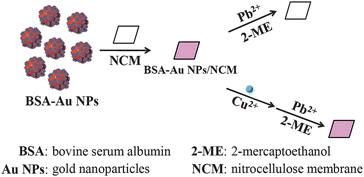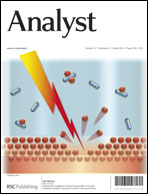We have developed a simple, low-cost, paper-based probe for the selective colorimetric detection of copper ions (Cu2+) in aqueous solutions. The bovine serum albumin (BSA)-modified 13.3-nm Au nanoparticle (BSA-Au NP) probe was designed to detect Cu2+ ions using lead ions (Pb2+) and 2-mercaptoethanol (2-ME) as leaching agents in a glycine–NaOH (pH 12.0) solution. In addition, a nitrocellulose membrane (NCM) was used to trap the BSA-Au NPs, leading to the preparation of a nanocomposite film consisting of a BSA-Au NP-decorated membrane (BSA-Au NPs/NCM). The BSA-Au NPs probe operates on the principle that Cu deposition on the surface of the BSA-Au NPs inhibits their leaching ability, which is accelerated by Pb2+ ions in the presence of 2-ME. Under optimal solution conditions (5 mM glycine–NaOH (pH 12.0), Pb2+ (50 μM), and 2-ME (1.0 M)), the Pb2+/2-ME–BSA-Au NPs/NCM enabled the detection of Cu2+ at nanomolar concentrations in aqueous solutions by the naked eye with high selectivity (at least 100-fold over other metal ions). In addition, this cost-effective probe allowed for the rapid and simple determination of Cu2+ ions in not only natural water samples but also in a complex biological sample (in this case, blood sample).

You have access to this article
 Please wait while we load your content...
Something went wrong. Try again?
Please wait while we load your content...
Something went wrong. Try again?


 Please wait while we load your content...
Please wait while we load your content...